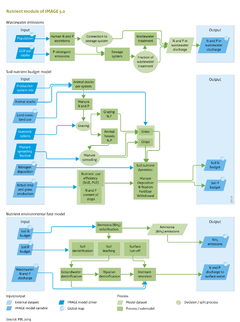Nutrients/Policy issues: Difference between revisions
Jump to navigation
Jump to search
No edit summary |
No edit summary |
||
| Line 10: | Line 10: | ||
• Institution of wastewater treatment installations; | • Institution of wastewater treatment installations; | ||
• Substitution of synthetic fertilisers by fertilisers produced from human excreta. This option has no consequences for nutrient budgets, but reduces wastewater flows. | • Substitution of synthetic fertilisers by fertilisers produced from human excreta. This option has no consequences for nutrient budgets, but reduces wastewater flows. | ||
IMAGE can also address strategies for reducing nutrient surpluses in agriculture, including five options illustrated in Figure 6.4.3: | |||
• Extensification (EX) assumes that 10% of ruminant production in mixed and industrial systems is shifted to pastoral production systems. | |||
• Increased feed conversion efficiency (FE) assuming a 10% lower N and P excretion for cattle, pigs, poultry and small ruminants in mixed and industrial systems. This is achieved by increasing the use of concentrates. | |||
• Improved manure storage systems (ST), considering 20% lower NH3 emissions from animal housing and storage systems. This means that the animal manure that is used for spreading contains 5% more N than under the baseline scenario. | |||
• Integrated manure management (IM), where for example all manure under the baseline scenario ends up outside the agricultural system (e.g. manure used as fuel (Figure 6.4.1), is recycled in crop systems to substitute fertiliser. In addition, there is improved integration of animal manure in crop systems, particularly in industrialised countries. | |||
• Dietery changes (DI), for example assumes that by 2050 10% of the baseline scenario’s beef consumption is replaced by poultry meat in all producing regions, without accounting for changes in agricultural trade. | |||
|Example=Extensification, increased feed efficiency and reduction in ammonia emissions from stables (cases EX, FE and ST) have minor effects on the global soil N budget. However, better integration of animal manure in crop production systems (IM), primarily in industrialised countries, and a change in the human diet with poultry replacing ruminant meat (DI), would have major effects on the global soil N budget.Other options that can be assessed, for which scenario variables originate from other IMAGE model parts, include: | |||
• Consequences of changes in crop production systems, such as increasing crop yields, which would lead to an improvement in fertiliser use efficiency; | |||
• Consequences of changes in livestock production systems (e.g. better management leading to lower excretion rates); | |||
• Changes in the distribution of total production over mixed and pastoral systems; | |||
• Changing human diets leading to changing production volumes. | |||
}} | }} | ||
Revision as of 11:37, 8 January 2014
Parts of Nutrients/Policy issues
| Component is implemented in: |
| Components: |
| Related IMAGE components |
| Projects/Applications |
| Key publications |
